Effects of Material Structure on Stress Relaxation Characteristics of Rapidly Solidified Al-Fe Alloy
Abstract
:1. Introduction
2. Materials and Methods
3. Results
4. Discussion
4.1. Effect of Changes in Particle Distribution by Increasing Extrusion Temperature and Annealing
4.2. Effect of Cold Rolling
4.3. Comparison of Stress Relaxation Characteristics of the Al-Fe Alloy with the Conventional Materials
5. Conclusions
- The distribution of Al-Fe intermetallic compound particles affects the conductivity and residual stress after the stress relaxation tests. The particles control the residual stress via the Orowan mechanism. Decreasing the mean inter-particle distance reduces the conductivity. The increasing in extrusion temperature and the annealing affect the particles’ distribution, with higher extrusion temperatures and more annealing reducing the residual stress and increasing the conductivity.
- The cold rolling of the Al-Fe alloys can increase strength at room temperature without changing electrical conductivity. However, in the study, the cold rolling did not have a positive effect on the stress relaxation characteristics of the Al-Fe alloy. The dislocations induced by the cold rolling would be associated with the effect on the stress relaxation characteristics.
- The residual stress after the stress relaxation test of the Al-Fe alloy was lower than that of C52100 H04 phosphor bronze. However, considering its density, the Al-Fe alloy is superior when compared with the case of the same mass. Since the conductivity of the Al-Fe alloy is more than twice as high as that of the phosphor bronze, the temperature rise when an electrical current is applied is small, making it easier to pass more current.
Author Contributions
Funding
Institutional Review Board Statement
Informed Consent Statement
Data Availability Statement
Acknowledgments
Conflicts of Interest
References
- Kaneda, D.; Kobayashi, K. Aluminum Alloy Plates and Sheets for Electrical Connection Parts. Kobe Steel Eng. Rep. 2015, 65, 25–28. [Google Scholar]
- Henckens, M.L.C.M.; Worrell, E. Reviewing the availability of copper and nickel for future generations. The balance between production growth, sustainability and recycling rates. J. Clean. Prod. 2020, 264, 121460. [Google Scholar] [CrossRef]
- Schoft, S. Joint resistance depending on joint force of high current aluminum joints. In Proceedings of the 22nd Conference on Electrical Contacts, Seattle, WA, USA, 23–23 September 2004; pp. 502–510. [Google Scholar]
- Ólafsson, D.; Vilaça, P.; Vesanko, J. Multiphysical characterization of FSW of aluminum electrical busbars with copper ends. J. Weld. World 2020, 64, 59–71. [Google Scholar] [CrossRef]
- Nomura, K. Technical Trends in High Performance Copper Alloy Strip for Connector and Kobe Steel’s Development Strategy. Kobe Steel Eng. Rep. 2004, 54, 2–8. [Google Scholar]
- Sun, Y.; Peng, L.; Huang, G.; Feng, X.; Xie, H.; Mi, X.; Liu, X. Effect of Mg on the stress relaxation resistance of Cu-Cr alloys. Mater. Sci. Eng. A 2021, 799, 140144. [Google Scholar] [CrossRef]
- Nomura, K. A new copper alloy, CAC5, with excellent stress relaxation resistance for automotive electrical connectors. Kobelco Technol. Rev. 2013, 31, 82–89. [Google Scholar]
- Mizuguchi, K.; Shioda, M.; Kubota, M.; Kusui, J.; Matsumura, K.; Murakami, I. Influence of extruded conditions on properties of Al-Fe powder alloy conductive materials using the rapid solidification. In Proceedings of the 134th Conference of Japan Institute of Light Metals, Osaka, Japan, 26–27 May 2018; pp. 193–194. [Google Scholar]
- Maeda, T.; Miyazaki, H.; Iwasaki, R.; Kobayashi, R.; Miyanaga, M. Heatproof Aluminum with Excellent Electric Conductivity and Thermal Conductivity. Sumitomo Electr. Tech. Rev. 2021, 92, 68–72. [Google Scholar]
- Kobayashi, R.; Funazuka, T.; Maeda, T.; Shiratori, T. Effects of Hot Extrusion Temperature Conditions on the Hardness and Electrical Conductivity of Rapidly Solidified Al-Fe Alloys. Materials 2023, 16, 5050. [Google Scholar] [CrossRef]
- Zhang, M.; Lewis, R.J.; Gibeling, J.C. Mechanisms of creep deformation in a rapidly solidified Al-Fe-V-Si alloy. Mater. Sci. Eng. A 2021, 805, 140796. [Google Scholar] [CrossRef]
- Wu, Y.; Zhang, T.; Chen, C.; Hosseini, S.; Zhang, X.; Zhou, K. Microstructure and mechanical property evolution of additive manufactured eutectic Al-2Fe alloy during solidification and aging. J. Alloys Compd. 2022, 897, 163243. [Google Scholar] [CrossRef]
- Japan Copper and Brass Association. Copper Strip Material Property Database. Available online: https://www.copper-brass.gr.jp/db_access/banjoudb/main.htm (accessed on 31 July 2023).
- Kuroyanagi, T. Copper and copper alloys in electronic materials. J. Jpn. Inst. Light Met. 1987, 37, 313–326. [Google Scholar] [CrossRef]
- Sumino, Y.; Nomura, K.; Sakamoto, H. Effects of Cold Rolling on Electrical Conductivity Behavior of Cu Based Alloy. J. Jpn. Inst. Copp. 2020, 59, 86–90. [Google Scholar]
- Kaneko, H.; Hirose, K.; Sato, K.; Tanaka, N.; Kanamori, H.; Mihara, K.; Eguchi, T. Development of a Cu-Ni-Si Copper Alloy Strip for Narrow Pitch Connectors. Furukawa Rev. 2010, 38, 1–7. [Google Scholar]
- Japan Copper and Brass Association. Standard Method for Stress Relaxation Test by Bending for Thin Sheets and Strips. JCBA-T309: 2004. Available online: https://copper-brass.gr.jp/wordpress/wp-content/uploads/jcba/JCBA-T309-2004.pdf (accessed on 31 July 2023).
- Japan Copper and Brass Association. Measuring Method for Factor of Bending Deflection by Cantilever for Copper and Copper Alloy Sheets, Plates and Strips. JCBA-T312: 2002. Available online: https://www.copper-brass.gr.jp/standard/files/JCBA-T312-2002.pdf (accessed on 31 July 2023).
- Qi, X.; Takata, N.; Suzuki, A.; Kobashi, M.; Kato, M. Change in microstructural characteristics of laser powder bed fused Al-Fe binary alloy at elevated temperature. J. Mater. Sci. Technol. 2022, 97, 38–53. [Google Scholar] [CrossRef]
- Tang, Y.; Tomita, Y.; Horita, Z. Mechanical Properties and Microstructures of Highly Fe-Containing Al-Mg-Si Alloys Processed by Severe Plastic Deformation under High Pressure. Mater. Trans. 2023, 64, 448–457. [Google Scholar] [CrossRef]
- Fickett, F.R. Aluminum—1. A review of resistive mechanisms in aluminum. Cryogenics 1971, 11, 349–367. [Google Scholar] [CrossRef]
- Tian, B.; Liu, P.; Song, K.; Li, Y.; Liu, Y.; Ren, F.; Su, J. Microstructure and properties at elevated temperature of a nano-Al2O3 particles dispersion-strengthened copper base composite. Mater. Sci. Eng. A 2006, 435–436, 705–710. [Google Scholar] [CrossRef]
- Ma, Z.; Liu, C.; Xu, L.; Huang, M.; Yang, Y.; Xu, Y.; Ma, B.; Zhan, L. Pre-strain-dependent creep ageing behavior of an AlCu alloy. Mater. Charact. 2022, 192, 112225. [Google Scholar] [CrossRef]
- Zheng, J.-H.; Jin, Y.; Xu, L.; Fan, C.; Song, W.; Chen, Y. Comparative Study of Creep and Stress Relaxation Behaviour during Ageing of 7050 Aluminum Alloy. Metals 2023, 13, 778. [Google Scholar] [CrossRef]
- Lodh, A.; Tak, T.N.; Prakash, A.; Guruprasad, P.J.; Keralavarma, S.M.; Benzerga, A.A.; Hutchinson, C.; Samajdar, I. Microstructural Origin of Residual Stress Relief in Aluminum. Metall. Mater. Trans. A 2019, 50, 5038–5055. [Google Scholar] [CrossRef]
- Mishra, S.; Yadava, M.; Kulkarni, K.N.; Gurao, N.P. Stress relaxation behavior of an aluminium magnesium silicon alloy in different temper condition. Mech. Mater. 2018, 125, 80–93. [Google Scholar] [CrossRef]






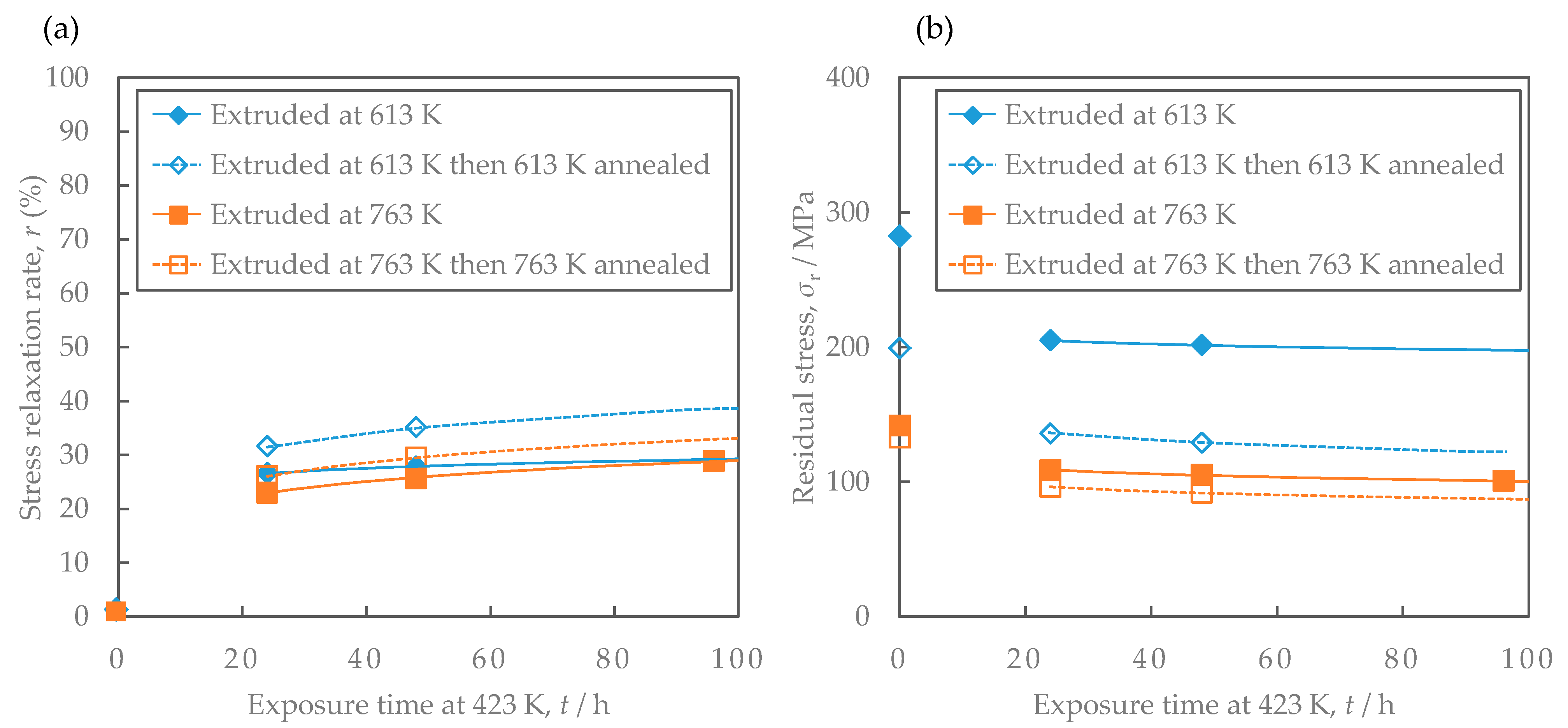

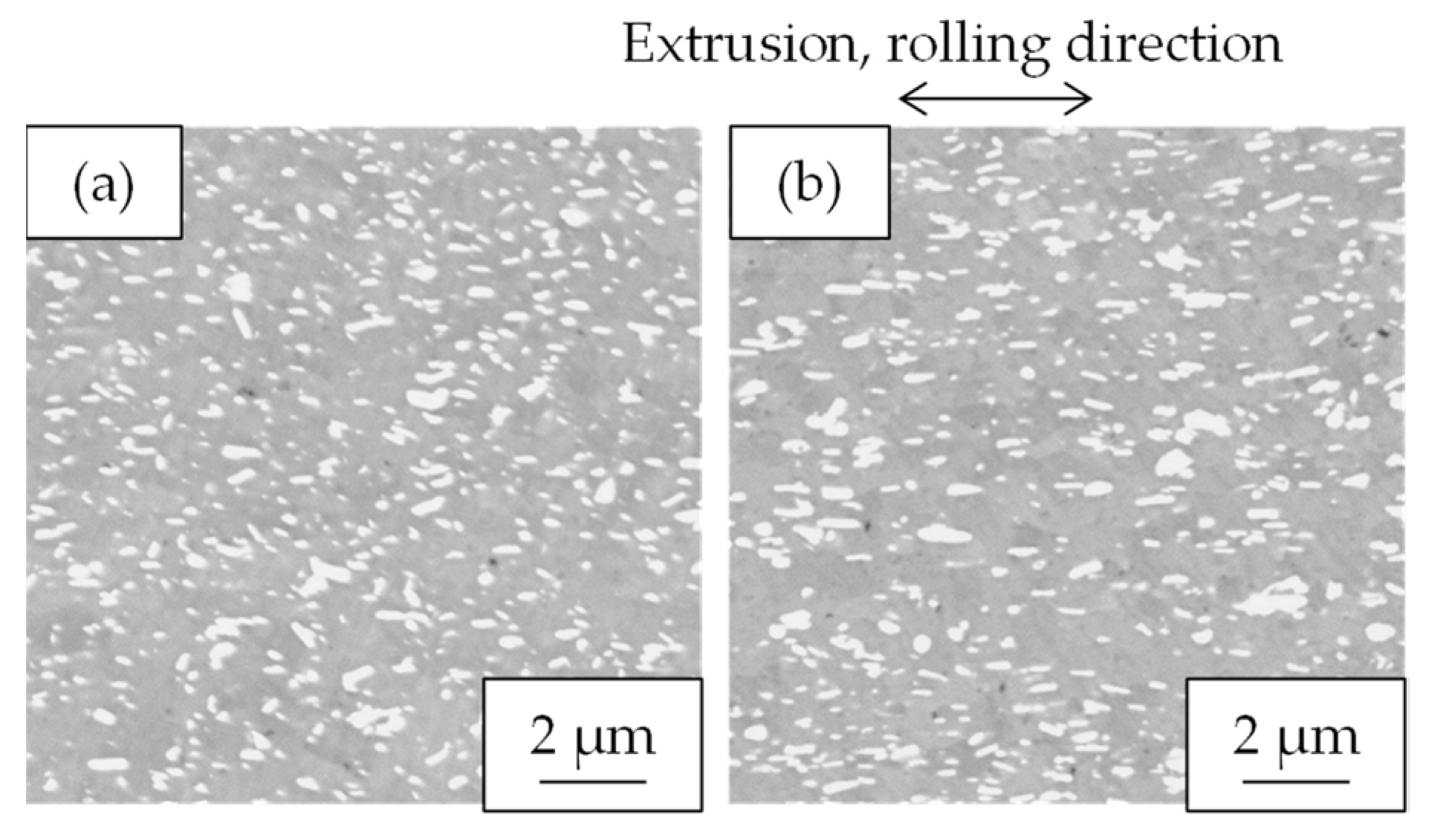
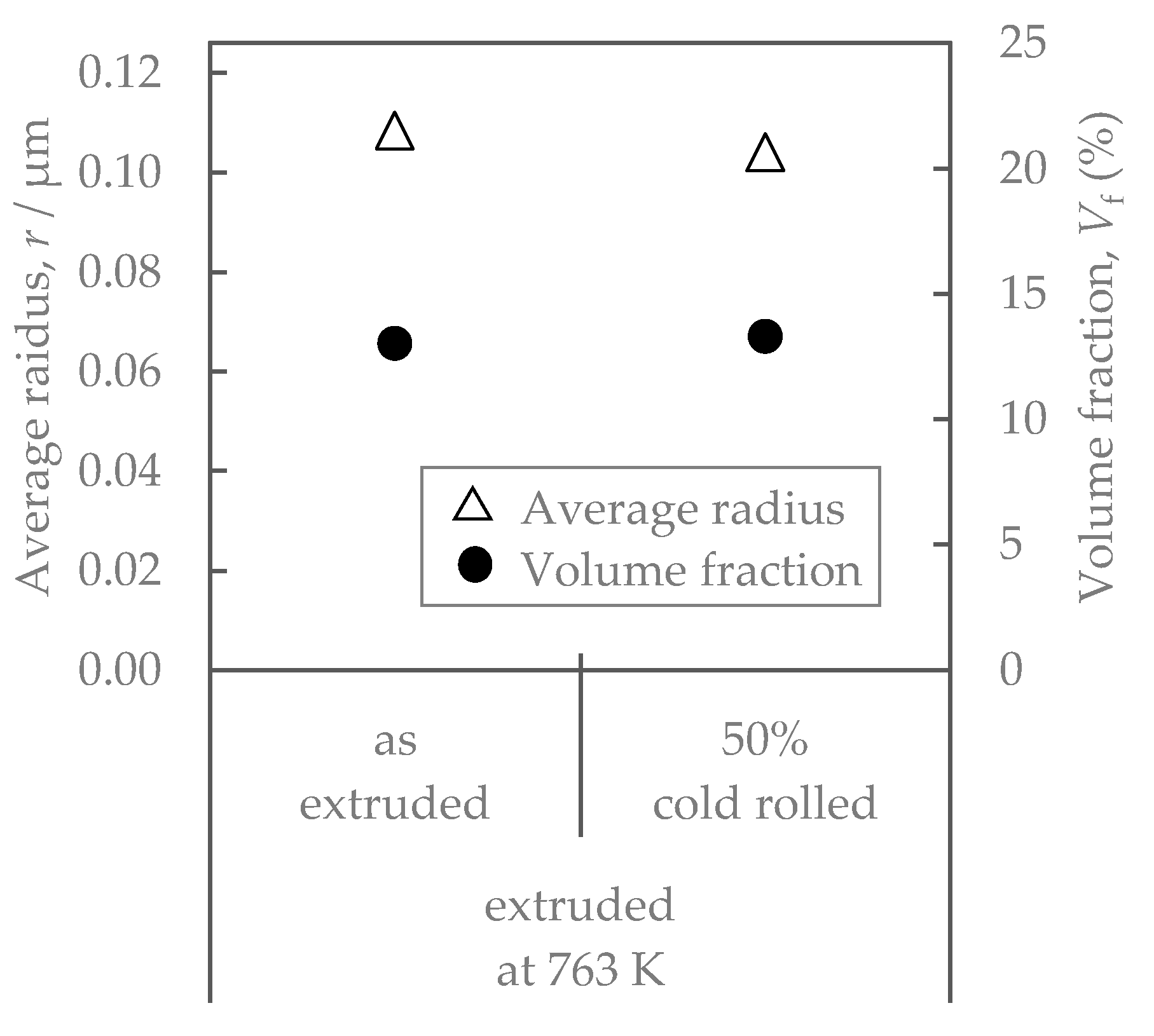
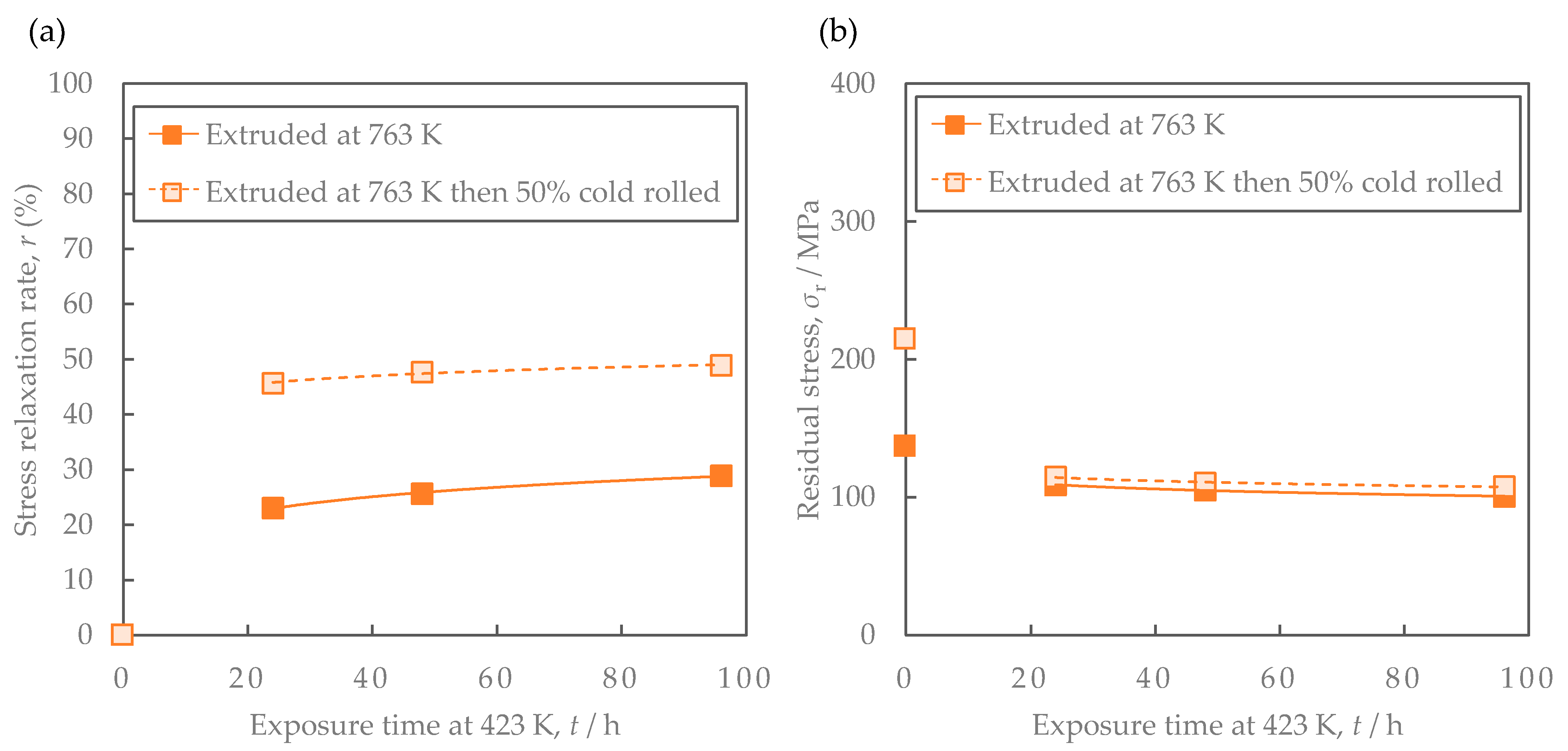
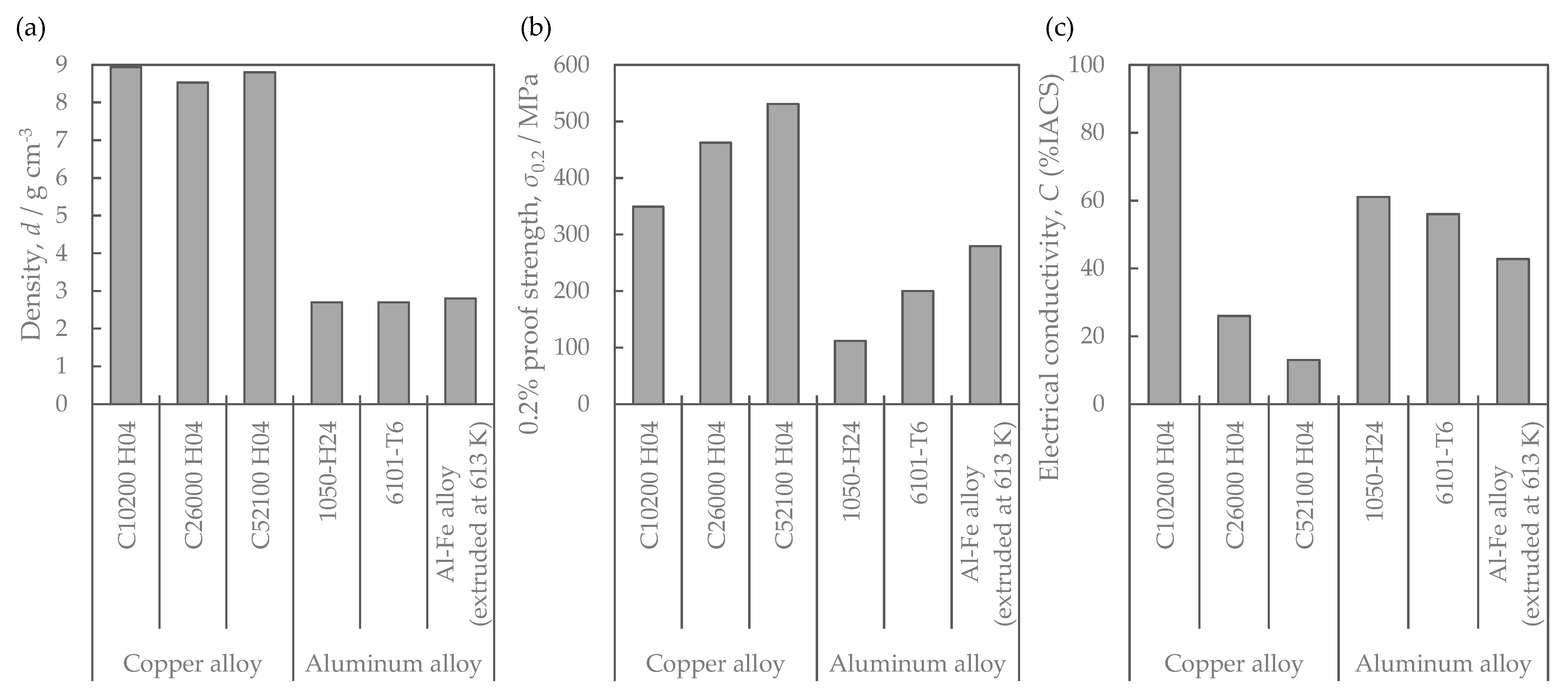

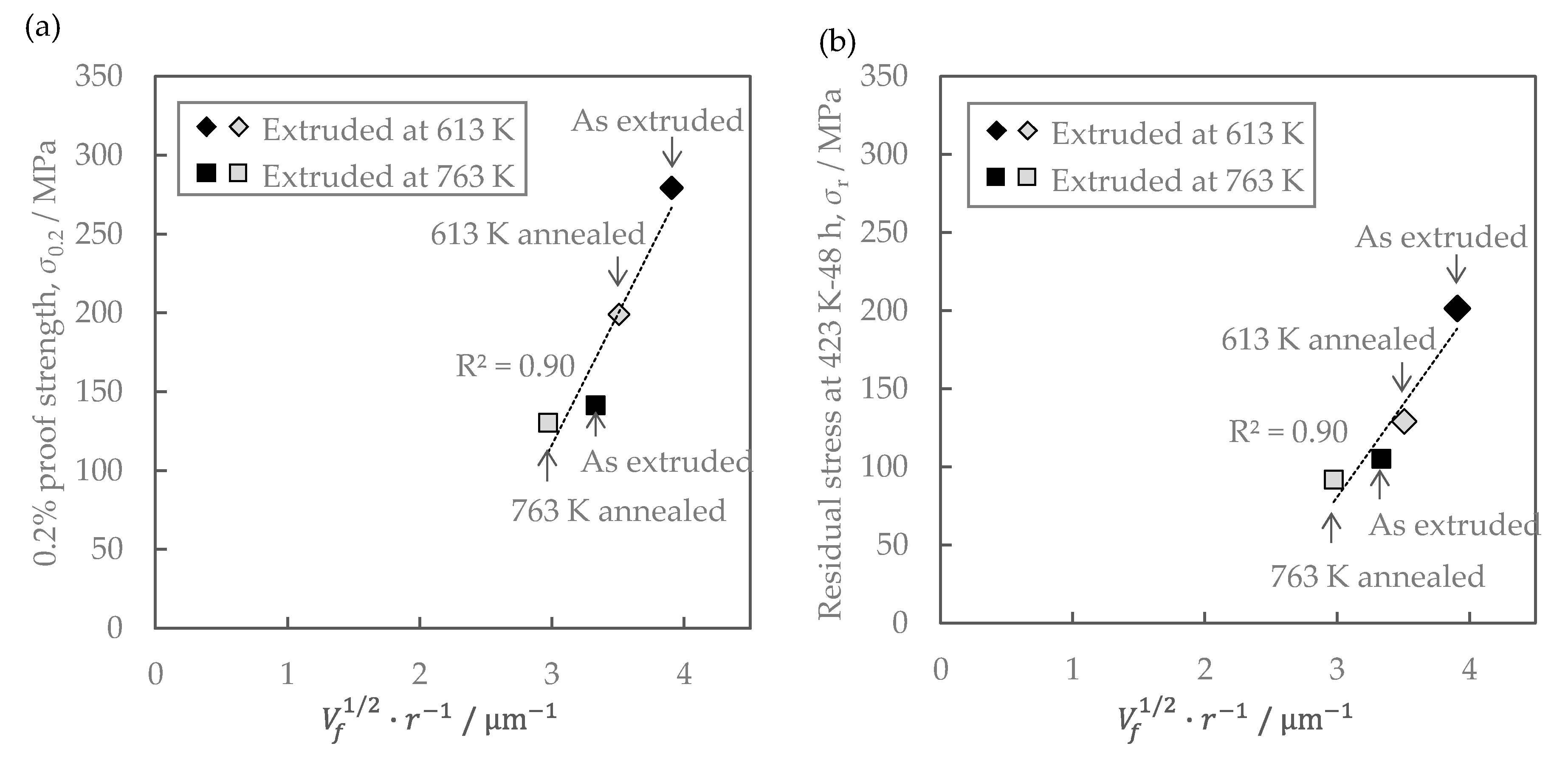
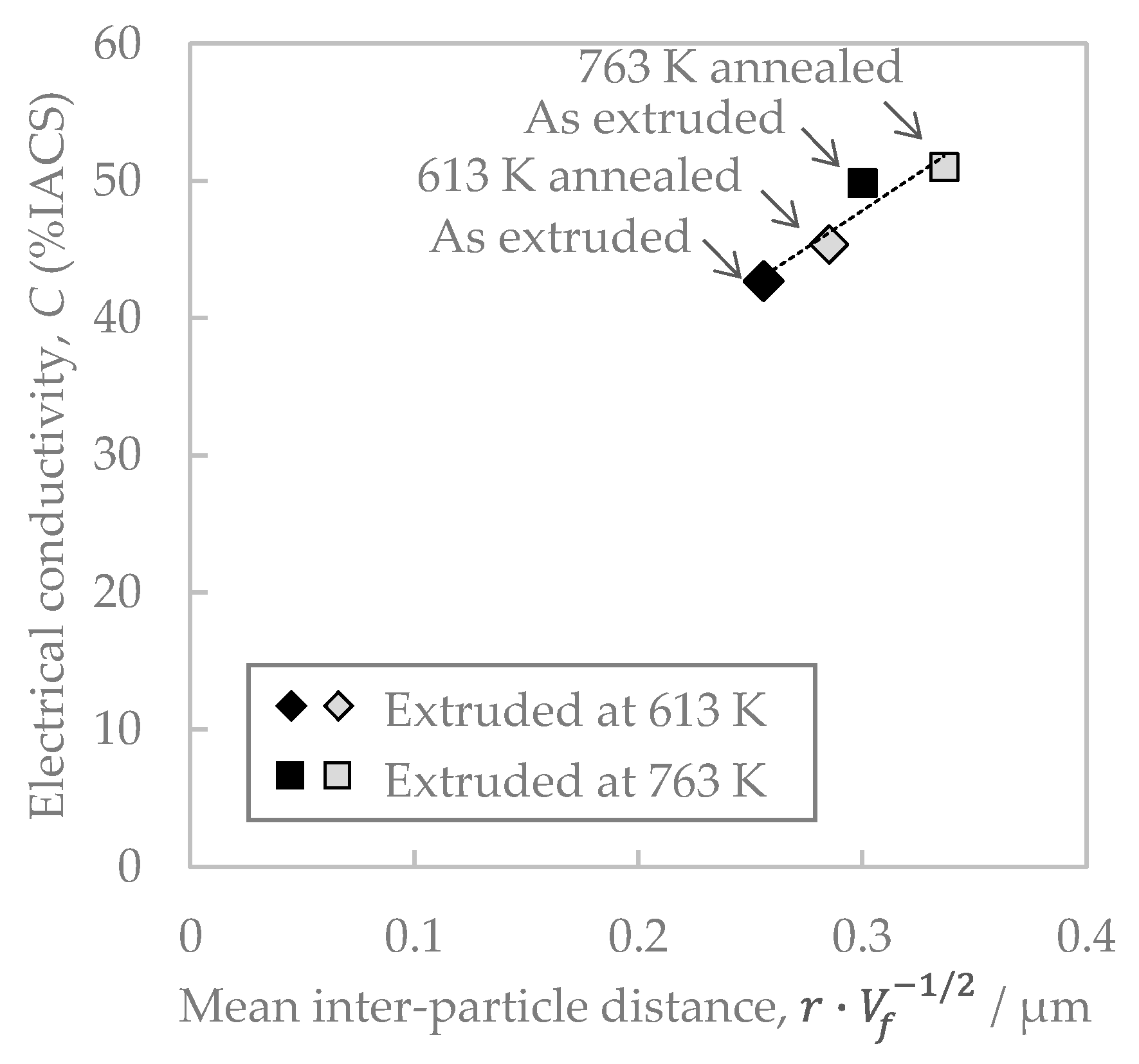

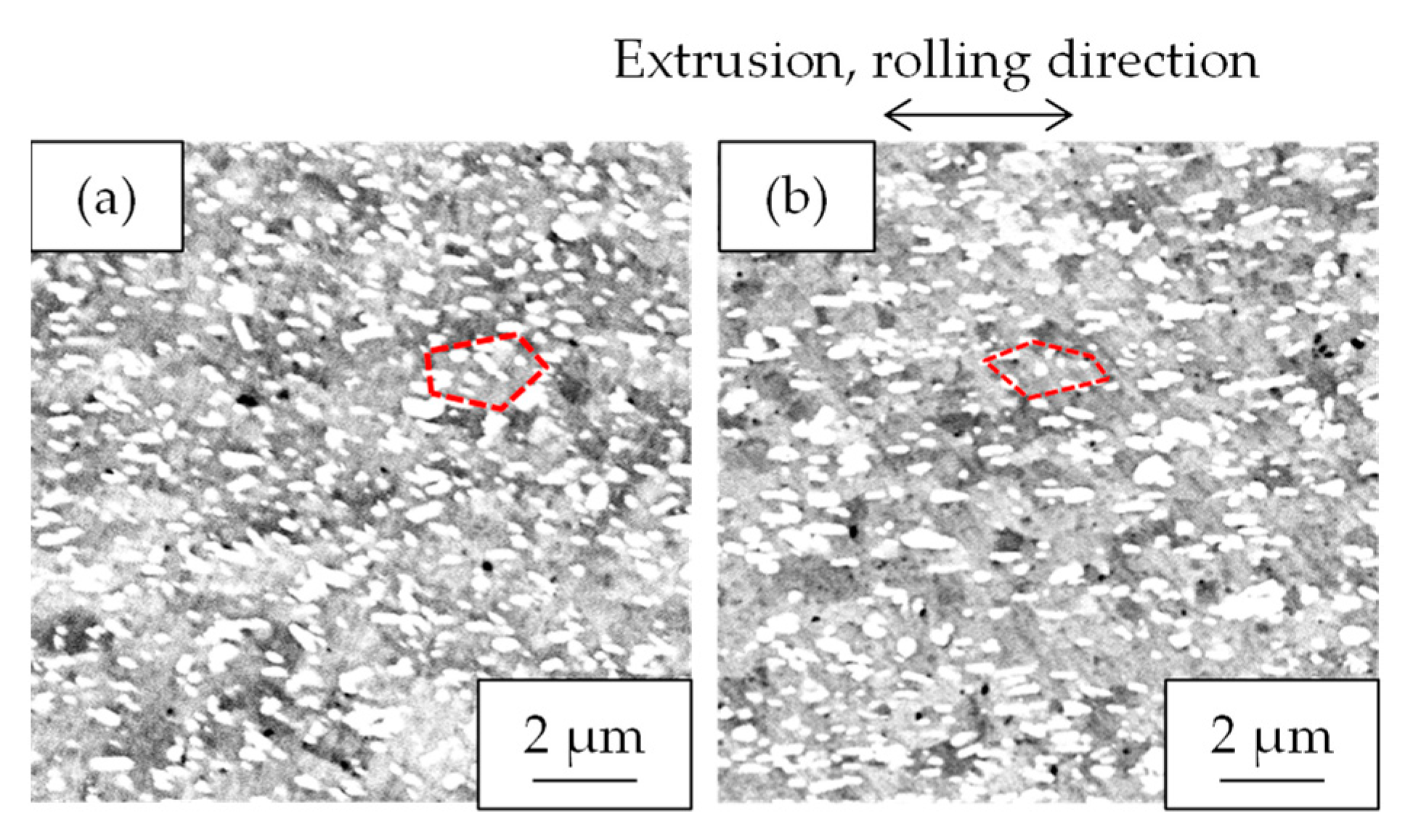
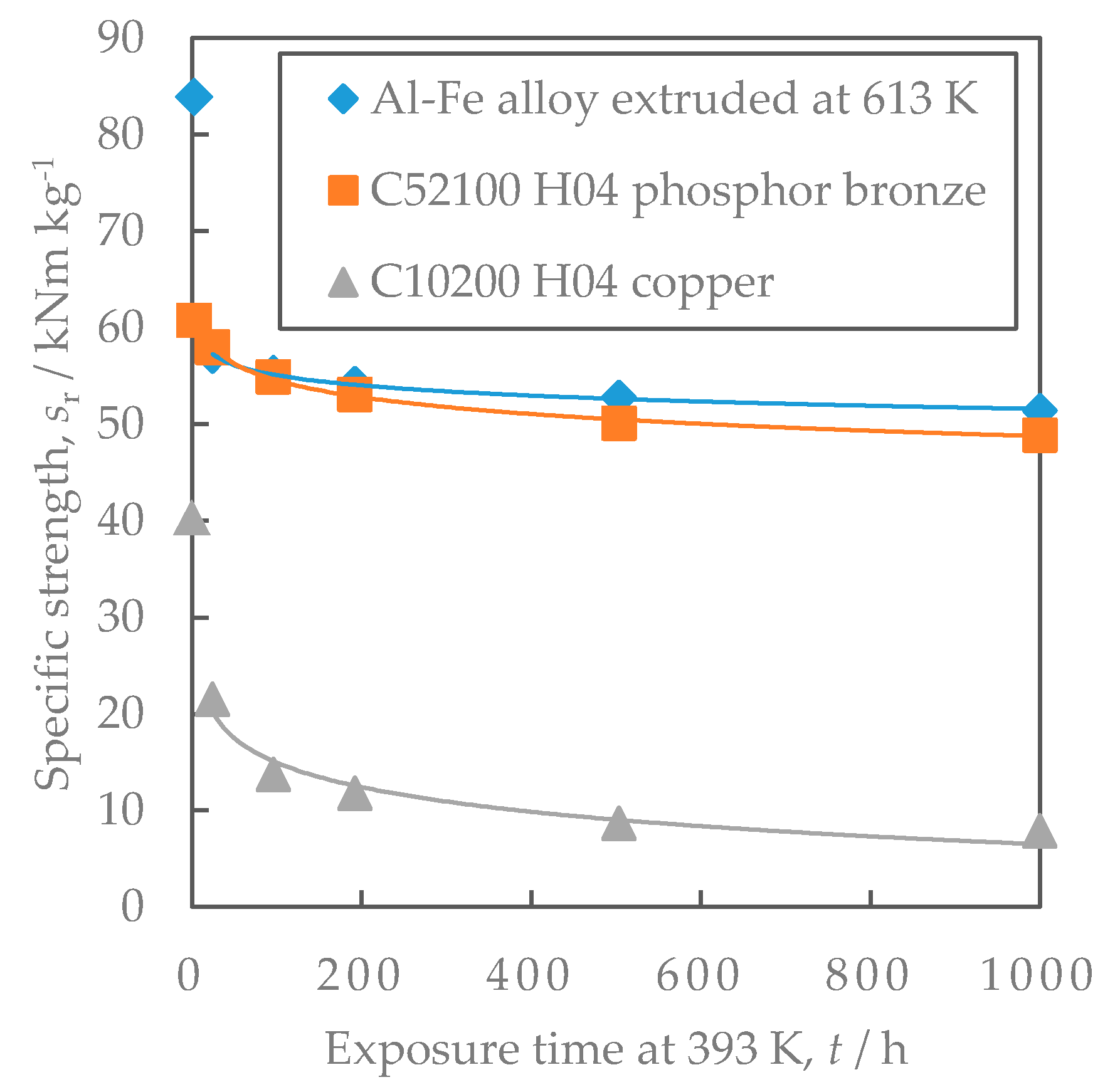
Disclaimer/Publisher’s Note: The statements, opinions and data contained in all publications are solely those of the individual author(s) and contributor(s) and not of MDPI and/or the editor(s). MDPI and/or the editor(s) disclaim responsibility for any injury to people or property resulting from any ideas, methods, instructions or products referred to in the content. |
© 2023 by the authors. Licensee MDPI, Basel, Switzerland. This article is an open access article distributed under the terms and conditions of the Creative Commons Attribution (CC BY) license (https://creativecommons.org/licenses/by/4.0/).
Share and Cite
Kobayashi, R.; Funazuka, T.; Maeda, T.; Shiratori, T. Effects of Material Structure on Stress Relaxation Characteristics of Rapidly Solidified Al-Fe Alloy. Materials 2023, 16, 5949. https://doi.org/10.3390/ma16175949
Kobayashi R, Funazuka T, Maeda T, Shiratori T. Effects of Material Structure on Stress Relaxation Characteristics of Rapidly Solidified Al-Fe Alloy. Materials. 2023; 16(17):5949. https://doi.org/10.3390/ma16175949
Chicago/Turabian StyleKobayashi, Ryohei, Tatsuya Funazuka, Toru Maeda, and Tomomi Shiratori. 2023. "Effects of Material Structure on Stress Relaxation Characteristics of Rapidly Solidified Al-Fe Alloy" Materials 16, no. 17: 5949. https://doi.org/10.3390/ma16175949
APA StyleKobayashi, R., Funazuka, T., Maeda, T., & Shiratori, T. (2023). Effects of Material Structure on Stress Relaxation Characteristics of Rapidly Solidified Al-Fe Alloy. Materials, 16(17), 5949. https://doi.org/10.3390/ma16175949








